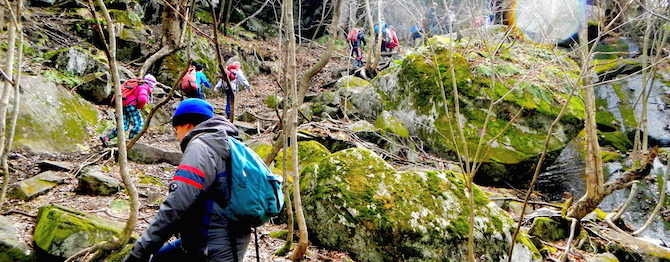
Forest Hiking
Overall Goal
By getting off trails and into the woods students are encouraged to look more closely at what’s around them, to be curious, to ask questions and to make connections to the natural world.
Grade 6 Curriculum Connections
Science and technology - Understanding life systems - Biodiversity
- assess human impacts on biodiversity, and identify ways of preserving biodiversity
- investigate the characteristics of living things, and classify diverse organisms according to specific characteristic
- demonstrate an understanding of biodiversity, its contributions to the stability of natural systems, and it benefits to humans
- Connect to STEM and Big Ideas (Fairness & Equity, Systems, Community, Diversity, Interdependence, Ability to Make a Difference, Equilibrium)
Social Studies - Heritage and Identity: Communities in Canada, Past and Present
- Application: assess contributions to Canadian identity made by various groups and by various features of Canadian communities and regions (Focus on: Cause and Consequence, Patterns and Trends)
- Inquiry: use the social studies inquiry process to investigate different perspectives on the historical and/or contemporary experience of two or more distinct communities in Canada (Focus on: Perspective)
- Understanding Context: demonstrate an understanding of significant experiences of, and major changes and aspects of life in, various historical and contemporary communities in Canada (Focus on: Significance, Continuity and Change)
Health and Physical Education
- Active Living
- Movement Competence: Skills, Concepts and Strategies
- Healthy Living
Program Description
Students will travel (by foot or snowshoe) into the forest on either a half day or full day excursion. Forest hikes can take on one or more themes such as, the forest through an aboriginal lens, adventure, biodiversity, inquiry, tracking, the forest in the winter, tree and plant identification and and uses, animal identification, forest succession, aquatic ecology habitats or an art experience. Whether climbing a cliff, coming across a waterfall, slogging through boot sucking mud or simply laying on the forest floor and taking in all the sounds, the absolute "Wow" factor and the wonder of a hike is a cherished memory of many students.
Success Criteria/Learning Goals
- Students will give 2 examples of biodiversity found in our forest.
- Students will describe a food web found in our forest.
- Students will give 2 examples of ways the First Nations used the resources found in our forest.
- Students will demonstrate an awareness of the gear needed on a forest hike.
Pre-Trip Activity
Living Connections is a hands on inquiry based activity for your school yard or local park which looks at the question "How are living things connected to one another?"
Next Step Environmental Action
Your class can become citizen scientists through NatureWatch, a community that engages all Canadians in collecting scientific information on nature to understand our changing environment. One of their programs is WormWatch which will have your students digging in your school yard for worms and completing and submitting observation forms. All the information you need is on the website. Happy digging.
Resources
From the website InvadingSpecies.com you can order Invasive Species - A Biodiversity Challenge. On page 86 find the activity Biodiversity Give and Take which consolidates learning about the various impact on biodiversity through a fun small group game.
For more resources please see Learning Resources on our website under Biodiversity.
